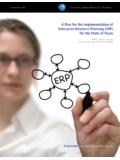Transcription of Whitepaper- ERP vs. PLM - Business Management …
1 1 ERP vs. PLM: What s the Difference? By JW Yates July 21, 2011 New York City, New York Business Management Systems 330 West 38th Street Suite 705 New York, NY 10018 (800) 266- 4046 2 Most companies in the manufacturing sector have become familiar with data Management systems of one form or another. Whether it is CRM, PDM, ERP or PLM, some kind of software is generally employed to manage the data needs at certain points in the manufacturing process.
2 Two of the oldest and most common data Management systems are ERP (Enterprise Resource Planning) and PLM (Product Lifecycle Management ). But what really is the difference between them? Recently, as many companies have sought to integrate the two systems, there has been growing interest in the topic. Depending on the industry, and the specifics of the company that is implementing the system, ERP and PLM can function in a very similar way.
3 Both systems keep track of your data and your property. Both have been proven as essential factors for successful manufacturing in the age of high technology. While ERP is used to manage the logistics of getting a product to market once a design is released, PLM, (being largely CAD- based) is used to achieve control over design and development information. As Tom Shoemaker (VP of Product Marketing at PTC) points out in an online video, PLM is to your intellectual property, what ERP is to your physical property.
4 In other words, PLM focuses on the planning before you commit to making a product, and ERP takes over from there. Both systems, however, often require customization and their functions could overlap from one company to the next. For instance some PLM platforms have been expanded both upstream and downstream, thus taking over some functions formerly thought to be the domain of ERP. In this whitepaper we will survey a lot of what s been written recently about the ways that ERP and PLM systems are being used by modern manufacturers.
5 We will look at the competing definitions for both systems and try to determine which system is best used for which process. Enterprise Resource Planning: ERP Enterprise Resource Planning can refer to either a software system, or a Business process that often includes an ERP software system. As an article on the IT Backbones website puts it: An ERP system is a Business Management tool used to fulfill the needs of many facets of a company including; finance and accounting, distribution, human resources, customer service and manufacturing.
6 ERP supports these various departments by delivering improved processes such as an automated 3 method for order fulfillment, providing a single location for tracking cost information to ensure consistency, and helping human resources to standardize their information ERP is most often utilized as a tool to manage the logistics of getting a product to market, that is, every step of the Business process after the product design stage.
7 It collects and collates the essential data from the manufacturing stages of a product redesigns, production runs, prototypes, etc. This might include test procedures, timelines, schedules and logistics. According to a recent whitepaper by software provider Sage ERP, ERP solutions have always offered powerful capabilities for managing operational data and improving Business efficiency. Today s organizations realize that ERP solutions are critical to helping them serve customers throughout their lifecycle and providing the accurate, up- to- date information they need to make better decisions more quickly.
8 And modern ERP solutions are delivering these capabilities with greater ease of use which further improves their benefits and ROI. With an ERP system in place, users can see the entire work process at a glance to instantly determine where they are in the process and the steps necessary to complete it. It improves information sharing and collaboration across the Business . Again, quoting from Sage ERP, Executives and managers no longer have to rely on spreadsheets or reports that have been compiled from multiple data sources and sent to them outside of the ERP ERP Definition : It is a company- wide computer software system used to manage and coordinate all the resources, information, and functions of a Business from shared data stores.
9 ERP relates to the integrated software infrastructure that supports the entire company Business process. ERP refers to a view of a company and all its parts as a connected whole, rather than small silos of activity. The term of ERP is originally derived from Manufacturing Resource Planning (MRP II) and Material Requirements Planning (MRP). MRP evolves into ERP when capacity planning activity and routing become a part of the standard software activity.
10 From 4 system. They can gain direct access to the information, which creates a single source of the truth and facilitates faster, more accurate decisions. For example, executives and managers can see high- level snapshots and can drill down to underlying reports to get more information. Here is another view from : ERP systems typically handle a company s accounting, logistics, distribution, shipping, manufacturing, procurement and sales orders.






